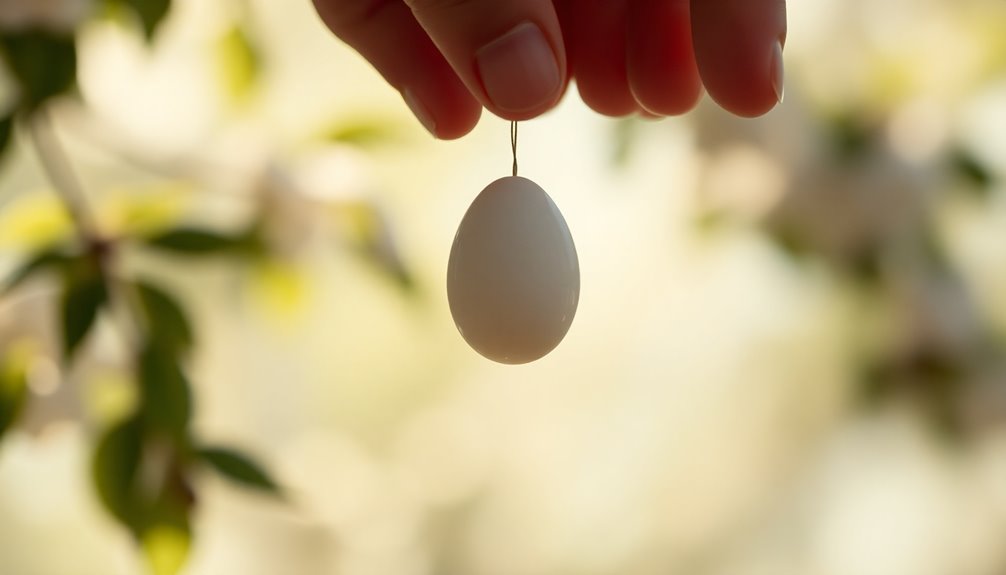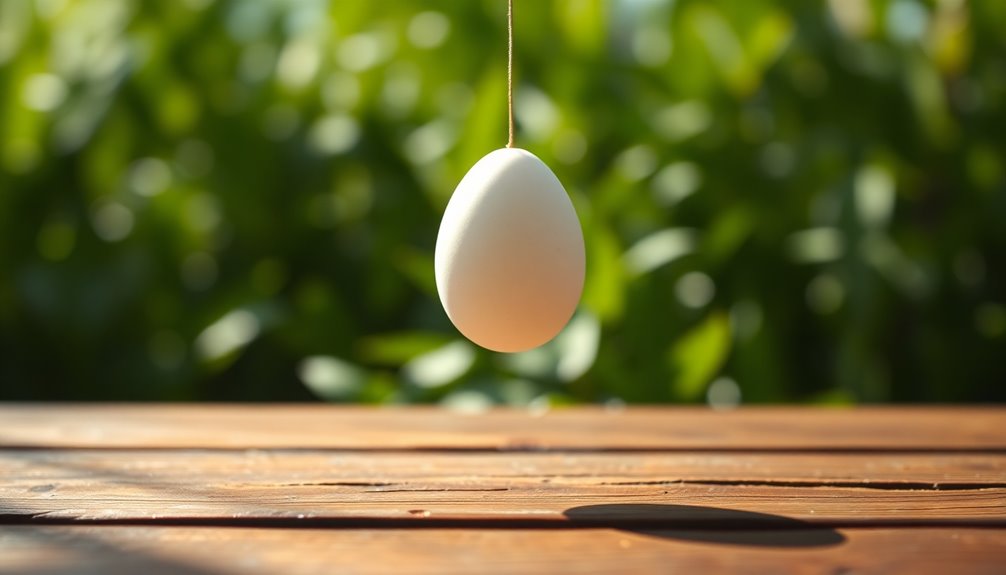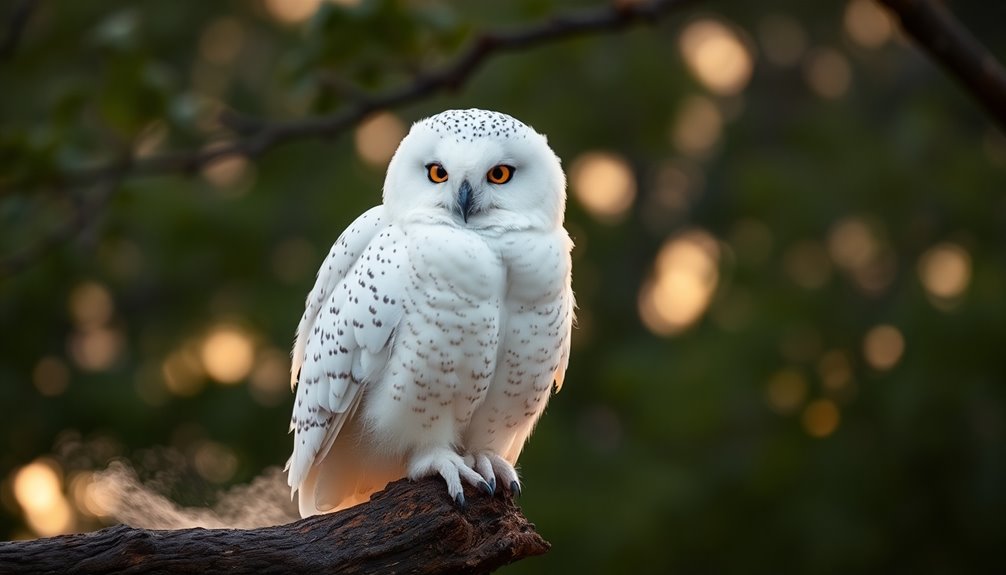Dropping an egg holds deep spiritual significance, teaching you about the fragility of life and the beauty of new beginnings. It serves as a reminder that letting go is essential for your personal growth and renewal. Embracing vulnerability helps you find strength amidst chaos, allowing you to evolve through loss. Consider how your connections with others support your journey; community plays a crucial role in healing and growth. This experience encourages you to set intentions and manifest change in your life. Discovering these lessons can lead you to a deeper understanding of your path ahead.
Key Takeaways
- Dropping an egg symbolizes the fragility of life, reminding us to embrace new beginnings and the beauty of creation.
- The act encourages letting go of outdated beliefs, fostering vulnerability and acceptance of change for personal growth.
- Acknowledging imperfections through mistakes leads to valuable lessons, promoting resilience and deeper emotional connections with ourselves and others.
- Engaging in community rituals facilitates collective healing, enhancing bonds and support during times of loss and renewal.
- Setting intentions and visualizing goals aligns our actions with desires, empowering us to manifest personal growth and transformation.
Symbolism of Dropping an Egg

Dropping an egg can really open your eyes to the fragility of life and the potential for new beginnings. This simple act holds profound spiritual meaning, reminding you that letting go of outdated beliefs is essential for personal growth and renewal.
The symbolism of a dropped egg highlights life's delicate balance, illustrating how chaos can coexist with order. When you witness the shattering of an egg, it serves as a metaphor for resilience. Just as an egg can break and create new life, you can embrace change and learn to rise from adversity.
It encourages you to find harmony amidst life's unpredictable moments, inviting mindfulness into your journey. In many cultures, eggs symbolize creation and fertility, reinforcing the idea of embracing change and the cyclical nature of existence.
Dropping an egg signifies not just loss, but also the potential for new beginnings. By reflecting on this experience, you can cultivate a deeper understanding of your own life's shifts, learning to appreciate the fragile beauty of each moment. Additionally, participating in events like themed breakfasts can provide community bonding opportunities that enhance your journey of personal growth.
Embrace the lessons from this symbolism, and let it guide you toward a more mindful, resilient approach to personal growth.
Lessons in Letting Go

Letting go is an essential lesson in personal growth, often requiring you to release outdated beliefs and emotions that no longer serve you. When you embrace the act of letting go, you create space for renewal, allowing fresh perspectives to emerge on your spiritual journey. This process not only fosters mindfulness but also highlights the interconnectedness of all life. Furthermore, recognizing the importance of subconscious power can deepen your understanding of how letting go can influence your dreams and aspirations.
Consider these key aspects of letting go:
- Embrace Vulnerability: Letting go invites you to be vulnerable, acknowledging that mistakes can lead to transformative experiences. This vulnerability can be a gateway to building resilience, helping you to navigate future challenges more effectively.
- Practice Mindfulness: Cultivating awareness of the present moment helps you appreciate fleeting experiences, which contribute to your growth. Additionally, maintaining high vibrational energy through mindfulness can enhance your overall well-being.
- Understand Sacrifice: Sometimes, you must sacrifice old patterns to gain greater insights and opportunities.
As you learn to let go, you reveal new possibilities, enriching your personal growth. Trusting this process reveals the beauty of interconnectedness and the importance of vulnerability in your life. Additionally, embracing this journey can enhance your emotional intelligence, allowing for deeper connections with yourself and others.
In the end, letting go isn't just about loss; it's about making room for renewal and embracing the journey ahead with open arms.
Embracing Vulnerability and Resilience

Embracing your vulnerability opens the door to recognizing your own fragility and imperfections.
When you confront these aspects, you reveal opportunities for growth and deeper self-awareness.
This journey not only strengthens your resilience but also transforms your mistakes into valuable lessons. Additionally, participating in spiritual retreats can provide a supportive environment for this transformative process.
Strength in Fragility
Often, people overlook the strength that lies within their vulnerabilities. By acknowledging your fragility, you open the door to profound personal growth and healing. Embracing this vulnerability fosters a deeper understanding of your emotional landscape and limitations.
When you recognize your weaknesses, you enhance your resilience, allowing you to face challenges with compassion rather than self-criticism.
Dropping an egg symbolizes life's unpredictability, reminding you that mistakes can lead to significant transformation and renewal. Accepting the fragility of existence invites you to practice mindfulness, savoring each moment and cultivating gratitude.
Consider these key aspects of embracing strength in fragility:
- Letting Go: Releasing expectations opens the path to growth and renewal.
- Emotional Awareness: Recognizing your feelings leads to deeper healing and understanding.
- Compassionate Resilience: Facing challenges with kindness nurtures your inner strength.
When you embrace vulnerability, you not only acknowledge your fragility but also discover the remarkable strength it can cultivate. Life's imperfections become opportunities for transformation, guiding you toward a more authentic connection with your true self.
Growth Through Imperfection
Recognizing that imperfection is an inherent part of the human experience can be liberating. The Spiritual Meaning of Dropping an egg teaches you the importance of embracing vulnerability. When you acknowledge your flaws, you open yourself to personal growth. Each time you drop an egg—or experience a setback—you gain valuable lessons that foster resilience. This process is often mirrored in relationship dynamics, where understanding and acceptance can lead to deeper connections. Additionally, engaging in trust-building activities can strengthen your relationships during times of vulnerability.
Accepting mistakes as natural allows you to transform failures into opportunities. This mindset helps you view challenges as catalysts for growth, leading to a deeper understanding of the fragility of life. By letting go of the need for perfection, you create space for renewal and self-acceptance. Furthermore, the ability to manage your emotions effectively can significantly contribute to your overall emotional regulation, enabling healthier responses to life's challenges.
Embracing your vulnerabilities enhances your capacity for resilience, enabling you to bounce back with greater strength and wisdom. As you learn to navigate life's imperfections, you also cultivate deeper emotional connections with others. Additionally, the process of stress management techniques can be instrumental in helping you cope with the emotional fallout of setbacks.
This journey of growth through imperfection not only enriches your own life but also fosters compassion and understanding in your relationships. So, the next time you drop an egg—metaphorically or literally—remember that these moments hold the key to your personal evolution and the beauty of being human.
The Journey of Renewal

The journey of renewal unfolds as you acknowledge your past experiences, allowing yourself to embrace change and growth as essential aspects of your spiritual evolution. This journey is often marked by moments of emotional tributes that remind us of the love we have received and shared.
Letting go of outdated beliefs is vital, as it clears the path for personal growth. As you navigate this transformative process, reflect on your emotional resilience and recognize the transformative potential that arises when facing life's challenges. Engaging in mindfulness practices during moments of perceived loss can deepen your connection to the present, fostering acceptance and understanding of the renewal process. Additionally, supporting a partner ready for parenthood can enhance emotional stability and strengthen bonds during times of change. It is essential to develop a structured routine that promotes stability and well-being throughout this journey, as this can help individuals remain grounded during transitions. The practice of goal setting can further clarify your intentions and provide direction as you move forward in your renewal journey.
This journey isn't just about individual progress; it also emphasizes interconnectedness. By fostering community support, you create an environment where everyone can thrive during changes.
Consider these elements as you set out on your journey:
- Acceptance of Change: Acknowledge that change is a necessary part of life.
- Emotional Resilience: Cultivate strength in facing challenges head-on.
- Community Support: Seek connections that nurture growth and provide encouragement.
Through this journey of renewal, you'll find that embracing change not only enhances your own life but also contributes positively to the lives of those around you.
The Role of Mindfulness

Mindfulness serves as a powerful tool when you encounter the emotional weight of dropping an egg, helping you stay fully present with the experience. By embracing mindfulness, you can process the emotional impact of loss or mistakes, allowing these moments to become opportunities for growth and self-discovery. Practicing mindfulness can also enhance your mental resilience, enabling you to navigate life's challenges more effectively. Additionally, regular engagement in practices like mindfulness can lead to improved mood and emotional well-being, similar to the effects of aromatherapy on anxiety.
Research suggests that mindfulness practices can significantly contribute to quality sleep, which is essential for optimal mental health and resilience.
Incorporating essential oils into your mindfulness routine can further enhance your emotional well-being and relaxation. When you practice mindfulness through breath awareness or meditation, you ground yourself during chaotic times, enabling you to respond with clarity and intention. This approach encourages you to adopt a compassionate perspective towards yourself, embracing your vulnerabilities and imperfections—much like the fragility of the egg.
Recognizing that mistakes are part of your spiritual journey fosters resilience and nurtures a deeper connection to your true self. As you cultivate mindfulness, you begin to appreciate the lessons learned from dropping an egg, transforming the experience into one of renewal. Engaging in daily practices such as gratitude journaling reinforces a positive mindset that enhances your journey of self-discovery.
It's about letting go of your fears and judgments, replacing them with acceptance. By doing so, you open yourself to a richer understanding of life's complexities, ultimately enhancing your journey of self-discovery. Embrace mindfulness, and watch how it enriches your spiritual path.
Release and Transformation

Dropping an egg can be a powerful reminder to embrace change and growth in your life.
It encourages you to let go of attachments that no longer serve you, opening the door to healing and transformation.
Embracing Change and Growth
Often, we find ourselves clinging to outdated beliefs and habits that no longer serve us. When you embrace the fragility of life, similar to the delicate nature of a dropped egg, you open yourself up to transformation and growth. Letting go isn't just about loss; it's about creating space for renewal and new opportunities.
By acknowledging the spiritual meaning behind this experience, you can cultivate a mindset focused on personal evolution. Consider these points:
- Adaptability: Embracing change requires you to be flexible and open to the unexpected, much like the need for continuous learning in personal development.
- Resilience: The aftermath of letting go can foster strength and emotional healing as you navigate new paths.
- Insight: Understanding that impermanence leads to profound insights about yourself and your journey.
- Growth Mindset: Adopting a growth mindset allows you to view challenges as opportunities for development.
As you navigate through life's changes, remember that each drop—each moment of letting go—can serve as a catalyst for growth. Embrace these shifts, for they're the stepping stones toward your transformation.
Letting Go of Attachments
Letting go of attachments is an important step toward personal transformation, allowing you to shed outdated beliefs and patterns that hinder your growth. When you drop an egg, it symbolizes the release of emotional burdens, urging you to confront sorrows and embrace healing. By recognizing the impermanence of life, you create space for renewal and deeper self-awareness.
| Emotional Burden | Release |
|---|---|
| Fear of Change | Trust in the Journey |
| Clinging to the Past | Embracing New Beginnings |
| Resistance to Growth | Acceptance of Impermanence |
Embracing the idea of sacrifice can lead to spiritual enlightenment, revealing the interconnectedness of your experiences. Mindfulness plays a essential role in this process, allowing you to stay present and appreciate the beauty of letting go. As you trust the journey of release, you'll find that relinquishing attachments opens pathways for personal evolution. The act of letting go may feel intimidating, yet it's necessary for fostering growth and inviting transformative energy into your life. Embrace this journey of release, and watch as you transform into a more authentic version of yourself.
Healing Through Release
In the journey of healing, releasing what no longer serves you can be a powerful catalyst for transformation. The symbolism of dropping an egg encourages you to confront outdated beliefs and attachments that hinder your personal growth. This cathartic experience allows you to engage with your sorrows, initiating a profound healing process that fosters resilience.
Embracing this process requires introspection and a willingness to let go. As you navigate this journey, consider these key aspects:
- Sacrifice: Understand that letting go often involves a level of sacrifice, freeing you from fears that limit your potential.
- Renewal: Recognize that release paves the way for renewal, opening doors to new beginnings and opportunities for personal evolution.
- Enlightenment: Trusting the process of relinquishment leads to enlightenment, helping you become a more empowered version of yourself.
As you drop the metaphorical egg, allow the emotional impact to guide you. Each release brings you closer to healing and deeper insights, transforming your life and fostering continuous personal growth.
Embrace this journey; it's essential for your transformation.
Community and Connection

Recognizing the significance of shared experiences, dropping an egg serves as a powerful reminder of the importance of community and connection. This act symbolizes how interconnectedness fosters collective healing. When you experience challenges together, it deepens your bonds and enhances personal growth.
Here's a look at how dropping an egg relates to community:
| Key Concepts | Explanation |
|---|---|
| Community | The foundation for shared experiences and support. |
| Open Communication | Essential for fostering mutual understanding. |
| Collective Healing | Shared rituals help to process loss and renewal. |
| Belonging | Strengthens relationships and creates a sense of safety. |
Through these shared experiences, you can witness transformation and communal support, reinforcing the idea of collective resilience. When you drop an egg, it's not just about the loss; it's about how you come together to support one another. Engaging in open communication during vulnerable times reinforces the bonds that create a true sense of belonging. Embrace the beauty of these connections, as they pave the way for healing and transformation within your community.
Intentions and Manifestation

The act of dropping an egg can also represent the powerful process of setting intentions and manifesting your desires. When you release that egg, it symbolizes letting go of doubts and fears, allowing clarity to emerge in your intentions.
Merging your desires with deliberate actions amplifies your manifestation energy, aligning your thoughts with your goals.
To effectively manifest your dreams, consider these key elements:
- Visualization: Picture your desires vividly, solidifying your intentions in your mind's eye.
- Trust and Faith: Believe in the process and remain open to receiving the outcomes you seek.
- Intentional Focus: Concentrate on specific intentions to accelerate your progress toward personal growth and renewal.
Frequently Asked Questions
What Is the Spiritual Meaning of Dropping an Egg?
Dropping an egg often makes you think about life's fragility and the importance of embracing change.
It symbolizes a moment of vulnerability, reminding you to let go of outdated beliefs and patterns that no longer serve you. This act encourages you to be present, cherishing each moment.
When you drop an egg, it can represent new beginnings, showing you that setbacks might lead to fresh opportunities for growth and transformation in your life.
What Does an Egg Symbolize Spiritually?
An egg symbolizes new beginnings, potential, and transformation in various spiritual traditions.
You might see it as a representation of fertility, embodying the promise of growth and renewal.
In addition, its hard exterior serves as a reminder of the importance of setting boundaries while nurturing your inner self.
This powerful symbol connects you to cycles of life, offering insights into creation, protection, and the journey toward personal and spiritual evolution.
What Is the Spiritual Meaning of Letting Go?
Letting go is like tossing a boulder off a cliff—liberating and exhilarating!
Spiritually, it means freeing yourself from the chains of past beliefs and emotional baggage. You're embracing change and discovering the beauty in life's fleeting moments.
By letting go, you're not just surviving; you're thriving, transforming struggles into golden opportunities for growth.
Trust the universe to guide you, and watch as new experiences unfold, leading you toward your true self.
What Is the Spiritual Use of Egg?
Eggs hold significant spiritual value in various practices. You can use them as symbols of new beginnings, representing your potential for growth and transformation.
In rituals, visualize your intentions while working with an egg to enhance manifestation. They often serve in purification ceremonies, absorbing negative energies to cleanse your spirit.
Their hard exterior reminds you of the importance of protection and healthy boundaries as you explore your inner self and spiritual journey.
Conclusion
In dropping an egg, you might find a reflection of your own journey—a reminder that life's fragility leads to growth. Just like the egg shatters, letting go opens doors to renewal. Embrace the messiness and vulnerability, knowing that each stumble transforms you. Picture a seed breaking through soil, reaching for the sun; with every release, you manifest new intentions. As you connect with others, you cultivate resilience, weaving a beautiful tapestry of shared experiences and rebirth.











